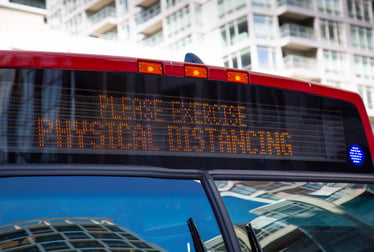How do you plan for an unknown future?
Scenario planning tools let you see the impact of your decisions before you put them into production.
If there is one thing we know about what’s happening in the world today, it’s that nothing is normal. In the world of transit planning and scheduling, this is most certainly true.
The term planning implies that you can propose a course of action based on a known set of circumstances. For example, a planner knows from historical ridership reporting that there are typically fewer riders on a weekend in June than on any given weekday in October. Understanding this, an agency can plan a June weekend schedule with a fair degree of accuracy. They can estimate the number of vehicles needed and how many drivers are required to do that work. But, now, for many cities around North America – and the world, really – everything is different. Nothing in historical ridership reports could have ever prepared transit for COVID-19.
 When state and local governments first closed all non-essential businesses and issued stay-at-home orders, ridership plummeted quickly and dramatically across North America. Agencies were forced to update their schedules to meet that demand better. Some went to weekend service schedules, others reduced the number of trips or shortened routes entirely. Working at a furious pace, they put new schedules into production as quickly as they could. In some cases, they did so without a clear picture of just what the downstream implications of this new schedule might be.
When state and local governments first closed all non-essential businesses and issued stay-at-home orders, ridership plummeted quickly and dramatically across North America. Agencies were forced to update their schedules to meet that demand better. Some went to weekend service schedules, others reduced the number of trips or shortened routes entirely. Working at a furious pace, they put new schedules into production as quickly as they could. In some cases, they did so without a clear picture of just what the downstream implications of this new schedule might be.
The situation remains very fluid, and depending on where you live, you are either gradually starting the process of coming back online or grappling with new cases that will likely increase or extend already challenging restrictions. Every scenario is unique, and since it’s impossible to predict week to week what the impact will be on your city, it’s critical that you put in place a variety of plans that take into consideration a variety of scenarios.
Scenario Modeling Tools Help Transit Agencies Plan
 One of the unique features of the MAIOR Transit Scheduling Suite is our built-in scenario modeling tools that let you see the impact your proposed schedule changes have on your service and your costs. Our tools make it easy for you to look at the different variables in your system, and by changing certain parameters, you better plan for what may lie ahead. From route design and timetable design to blocking and run-cutting optimization, we provide you with what amounts to a “virtual sandbox” where you can play around with various scenarios without having to put them into production.
One of the unique features of the MAIOR Transit Scheduling Suite is our built-in scenario modeling tools that let you see the impact your proposed schedule changes have on your service and your costs. Our tools make it easy for you to look at the different variables in your system, and by changing certain parameters, you better plan for what may lie ahead. From route design and timetable design to blocking and run-cutting optimization, we provide you with what amounts to a “virtual sandbox” where you can play around with various scenarios without having to put them into production.
Plan for More or Less Service: Vehicles and Drivers
Every scenario impacts the number of vehicles you will need and, in turn, the number of drivers you’ll need to run that service. If your agency is cash-strapped and looking to furlough operators, running different scenarios in the blocking and run-cutting functionalities lets you quickly see how many drivers you’ll need for your new reduced service to better plan for temporary force reductions.
Alternatively, if you’re increasing the number of vehicles to meet onboard capacity mandates, you may need more drivers than before. With our scenario modeling tools, you can see exactly how many vehicles and drivers you’ll need based on your capacity parameters to quickly assess resource requirements and costs before you put them into production.
Plan to Include Sanitizing/Cleaning Procedures in your Schedules: New Rules
Many transit agencies and operators are scheduling their services, taking into account a variety of rules to reduce COVID-19 spread.
Vehicles returning to operate on a unique route instead of operating on an interlining basis change the blocking optimization game. Drivers having to include in their schedules specific sanitizing procedures to guarantee their safety and health increase the time before performing revenue service, which must be measured and included in their duties schedules to make sure the company operates efficiently. Also, companies may prefer to make driver transfers only at depots and not at nodes as before. This must be included the set of run-cutting optimization parameters so that the MAIOR Transit Scheduling Suite efficiently produces useful driver schedules.
Getting ready for all these possible changes using scenario modeling can help the company better prepare for the “new normal” and will help schedulers find the best operational options reducing the impact on costs.
Plan for a Variety of Scenarios with the MAIOR Transit Scheduling Suite
The truth is, nobody knows how long it will take us to return to pre-COVID ridership levels or if we ever will. Will cases in a city spike unexpectedly? Will cases continue to decline, enabling businesses to open and sending employees back to work?
Because it’s impossible to predict with any degree of certainty, it is critical that agencies have a variety of vetted plans on file that can be implemented quickly to meet reduced or increased demand. By doing the scenario modeling up front, an agency can better plan for an unknown future and put the vetted scenario into production quickly as needed knowing specifically how many drivers and vehicles will be required and what the downstream implications will be for each in terms of cost and efficiency.
Examples of potential scenarios
Scenario A: Normal ridership returns to pre-Covid levels
Scenario B: Ridership never returns to pre-Covid levels – maxes out at 75%
Scenario C: Resurgence in cases, stay-at-home order issued, ridership falls to 20% of pre-COVID levels
Who could ever have imagined that the world would find itself grappling with a global pandemic that would effectively shut down our industry and send ridership numbers plummeting? The answer, of course, is pretty much no one. But regardless, the fact of the matter is that there are a significant number of people who depend on the services you provide every day, and together, through technology and sheer determination, we must do everything possible to ensure that we continue to do what we must to make sure that they get where they need to go, as quickly and efficiently as possible.
Learn more about scenario modeling and the MAIOR Transit Scheduling Suite.